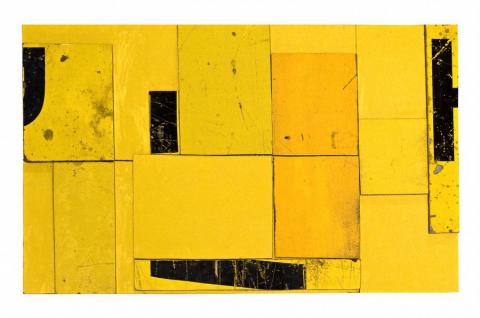RESERVE, 1997
Rosalie Gascoigne
retro-reflective road signs on wood
35.5 x 56.5 cm
signed, dated and inscribed verso: RESERVE / Rosalie Gascoigne / 1997
Roslyn Oxley9 Gallery, Sydney
Private collection, Sydney
Rosalie Gascoigne, Roslyn Oxley9 Gallery, Sydney,1 April - 2 May, 1998, cat. 21 (label attached verso)
Rosalie Gascoigne: Plain Air, City Gallery Wellington and Victoria University Press, Wellington, 2004, p. 10 (illus.)
Exhibited in 1998, Reserve belongs to a group of works whose titles all resonate on a broad platform of personal remembrances and beloved landscapes. Grasslands II, Siesta, Solitude and Indian Summer, all assembled from retro reflective road signs which flare and energise the space they occupy, are visual sonnets to the landscapes of Gascoigne's youth in New Zealand and later life in Australia.
As noted by Gregory O'Brien, 'describing one's surrounding and exploring one's inner life have long been fundamental concerns for artists who are, as Gascoigne put it, 'like the bards of old, they sing a song of their district.' Her works, then, are odes to the surfaces on which life is lived' be they geographical or domestic, flat lands or hardboard. As well as bespeaking an inner life of remembered places, the works sing a song of a day-to-day life spent between the wide-open expanse of air, earth and light and the studio-yard crammed with old crates and road signs. When Gascoigne said: 'I look forward to foaming seas of crops signing songs of the place,' she was referring to both being in the landscape and making that manifest in her art.'1
The transportive nature of works such as Reserve manifests the artist's desire to become, as she put it, 'airborne'. Such was her notion that, 'poetry and art move from where one is at to somewhere else. One has to be airborne to succeed with either. Pleasures of the eye are important to me. Nature provides for the most part. But the blow to the solar plexus provided by the right word in the right place, or the new word in the right place, gives me pleasure beyond belief.'2
1. O'Brien, G., Rosalie Gascoigne: Plain Air, City Gallery and Victoria University Press, Wellington, 2004, p. 39
2. Ibid., p. 22
MERRYN SCHRIEVER
